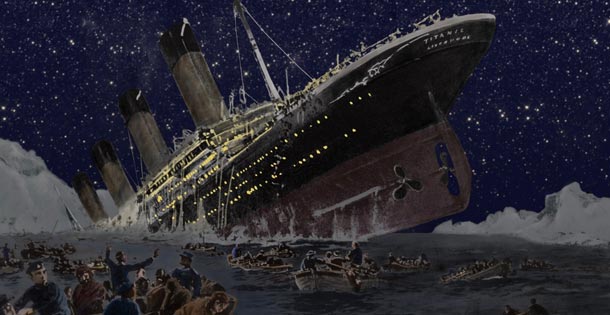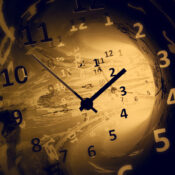O’Henry walked across the room, took one look at him, and yawned. That was enough for John Lyon. God, he said to himself, even the cat thinks I’m boring. He could no longer avoid it. Three months into retirement, and his life had become a tedious routine. It was the same thing day after day, and would continue that way until he died. He needed something new and interesting to save his sanity. He needed a project.
“I’m going to build that,” he declared.
His wife looked up from her book. “Did you say something, dear?”
“I said I’m going to build that.” He pointed at the television.
“You’re going to build a television?”
“What? No. That’s ridiculous. I mean I’m going to build the Titanic.”
Mary Ann realized that John had tuned to a show on the Discovery Channel about the famous ship. Somewhat befuddled, she looked at the program, then at her husband, then back down at her book. “Okay,” she said.
John didn’t intend to build the ship to its full size, of course. He wasn’t a lunatic. His plan, rather, was to build a meticulously detailed scale replica from scratch.
He set up shop on the dining room table, laying down sheets of newspaper to catch the excess sawdust that would kick up while he worked. When Mary Ann walked in, she asked if he was out of his mind, ordered him to take everything down to the basement, and warned him that if she found just one cut in her table, she’d take the saw and kill him with it while he slept.
John, remaining dignified, rolled up the newspaper and told her she was being unreasonable. “I bet Thomas Andrews’ wife never threatened to kill him,” he added.
Thomas Andrews was the chief architect of the RMS Titanic. They talked about him on the Discovery Channel show. Painstaking and meticulous, Andrews would walk all over the ship and jot down in a little notebook any improvements he felt were needed. John liked that, and wanted to bring the same kind of fastidiousness to his model. He found in the garage an old book about the ship that contained a glossy black-and-white photo of Andrews. He propped it in the corner of his workbench for inspiration.
An hour later, he poked his head upstairs and said to Mary Ann, “If I told you that O’Henry is Krazy Glued to the floor, would you tell me that you had a bottle of acetone handy?”
After freeing the cat, John worked long into the night, and the late hours soon became a habit. Over a period of weeks, his model started looking like a real ship. More than that, it started looking like Titanic. He was delighted by his progress.
One night, when the light bulb over his workbench blew out, John went rummaging through the closet for a replacement. A pack of 40-watts sat on the top shelf, and behind them was an old, boxy radio with the power cord wrapped around it. Back at his bench, John screwed in a new bulb and plugged in the radio, curious whether it still worked.
Dialing the stations, he heard mostly static, until he picked up a man speaking in a rich baritone. It was one of those wacky AM talk shows about the supernatural. Callers would recount their experiences with aliens and ghosts and such, and the host (Phil, the guy with the deep voice) would take them all very seriously. John found the show entertaining and kept it on in the background as his work progressed.
After five months, the replica was ready. John covered it with a light cloth, brought Mary Ann down to the basement, and unveiled it like a magician. She gasped.
The finished product was stunning in its accuracy. It looked like someone had zapped the real ship with a shrinking ray and placed it on John’s workbench. All Mary Ann could manage to say, in her amazement, was, “Now what?”
“What do you mean?”
“I mean what are you going to do with it?”
John said he hadn’t thought about that, but he was open to suggestions.
A few hours later, she brought him a suggestion.
“Model Enthusiast?” He read aloud the name of a magazine that Mary Ann had taken out of a brown paper bag filled with groceries. “I found it at the supermarket,” she explained. “I never heard of it either. But look here.” She flipped the magazine to the back cover, where there was a full-page advertisement for a competition. John scanned the copy:
“Grand Prize $5,000 … currently accepting submissions for our annual “Making History” contest … your model must be an accurate, scale replica of an artifact, building, transport, or other structure of historical significance … include with your submission several 8×10 photographs showcasing your work … deadline is Friday, March 20th.”
John beamed at Mary Ann. “Where do we keep the camera?”
He set the old Kodak on the tripod five feet from his model. He started with some wide shots, capturing the grandeur of the ship, and then moved in for the details. As usual, he was working late and listening to the AM talk show hosted by Phil. America the Bizarre with Phil Lazar it was called.
“It’s Free Rein Friday, folks,” Phil was saying. “Anything you want to talk about is fine by me. We have Tom on the line. Go ahead, Tom. Welcome to America the Bizarre. Where you calling from?” Silence followed Phil’s question. “Go ahead, caller. You’re on the air. What’s your topic?”
A series of electronic beeps sputtered over the airwaves, stopped, then started again. The beeps sounded faint and far away. “Bad connection, caller,” Phil said. “Give us a try again later.”
John finished his photo shoot, unplugged the radio, and went up to bed.
The next day, he poked his head out of the back door.
“Mary Ann, magnifying glass?”
She was working in the garden. “I’ll need a little more, dear.”
“Where do we keep it?”
She told him that it was probably next to the tobacco pipe and deerstalker cap above the fireplace, so John went to the store and bought one.
“Look here and tell me what you see.”
John laid out the photos of the model on the dining room table. He thought there was something strange about one of them.
“I see a window,” Mary Ann said, looking through the magnifying glass.
“You see a window. Anything else? It’s a porthole, by the way.”
She looked closer, leaning down until her nose nearly touched the glass.
“I see a window, John.”
“You don’t see a man’s face as well? Right here? Looking out from the window? Call it porthole, please.”
“A man’s face?” She looked again. “Did you put figurines inside the model? That’s clever!”
He told her no, he did not put figurines inside the model. There was no inside of the model. It was only a façade.
“Well, maybe if you look at it long enough, you could make out a face. Like seeing faces in clouds, or something like that.”
John sighed and plucked the magnifying glass out of her hand. “Forget it.” He knew it was absurd, but John could not “unsee” the face in the picture. He went downstairs to the model and examined the porthole in question. All he saw, however, was hollow space, which was to be expected, but he still felt disappointed not to find a little person in there waving at him.
On the radio, Phil was holding court on America the Bizarre.
“George from Ohio. Hello, sir. You’re on the air.”
“Phil, thanks. Big fan. Listen, that call from the other night. The one with the weird beeps. You remember?”
“Sure, what about it?”
The book on John’s workbench was still opened to the photo of Thomas Andrews. He sat up straight, taking new notice of it. Impossible, he thought.
George from Ohio said, “I was in the Army Signal Corps during Vietnam. We used Morse code during that war, if you can believe it.”
John slapped the photo with the mysterious face in the porthole onto the table. He set the magnifying glass over it and then pulled over the picture of Andrews so that the two were side-by-side.
“Phil, those beeps on that call, that was Morse code.”
“You’re kidding. Morse code? What did it say?”
George said he did not have time to write it all down, so Phil replayed the tape. As the beeps again pattered over the airwaves, John stared in disbelief at the image of the face in the porthole. It was Thomas Andrews. He was sure of it. It was him or his twin brother.
“Okay, George,” said Phil when the tape ended. “Decode it for us.”
“Yep. That’s a CQD distress signal.” He cleared his throat before continuing. “Get this, it says, ‘We are in collision with berg. Sinking head-down.’ Then it gives the coordinates 41.46 north, 50.14 west — that’s somewhere in the North Atlantic — and ‘Come as soon as possible.’”
John was too stunned to move. The eyes of Thomas Andrews stared at him from the black-and-white photograph, but the windows and the portholes on his model of the ship remained dark and empty. “Sounds like someone out there is having a little fun with us,” Phil said.
George laughed. “Could be the first crank call ever with a telegraph, Phil.”
“Believe it or not,” the host continued, “Morse Code Tom is calling again on line two. I’m gonna put you on hold, George, okay? Keep your ears open and get ready to do some more decoding.”
John held the radio in his lap and turned the volume to the max.
More beeps now, emerging from a shower of static. Phil let it run until it stopped and then switched back to George.
“Close hatch on D-Deck,” George translated. “Starboard side.”
Neither Phil nor George could make sense of the message. John was equally baffled until he turned his model 180 degrees and looked at the starboard hull. The hatch on D-Deck was wide open. Startled, he reached over and shut it.
“Back to Tom on line two,” Phil reported. “I tell ya, folks, I’m not sure how much I want to indulge this crank caller.”
John squeezed the radio as though it were Phil’s head. “Take the call!”
He did. The Morse code sounded again. Then it was back to George.
“‘Sinking fast!’” George said. “‘Ship design flawed. Must repair.’ Well, it’s too late for that, ain’t it?”
Phil chuckled and thanked George for his help. “Tom,” said the host to the mystery caller. “Not sure what your angle is here, but we can’t take up any more airtime with this. Clever idea, though. Hope you get yourself to a lifeboat!”
John nearly screamed in frustration. His first impulse was to run for the phone and call the show, but when he jumped from the stool, he was still holding the radio and yanked the power cord from the wall. Desperate, he lunged and plugged it back in. “Top of the hour,” Phil was saying. “Time for the news.”
John had the phone in his hand a minute later. Phil’s producer answered and asked what topic John wanted to discuss on the air.
“It’s about the Morse code caller.”
“You him?”
“No, not me. It’s Thomas Andrews.”
“Who’s that?”
“Designed the Titanic.”
“Ain’t he dead?”
“Oh, yes. He went down with the ship.”
The producer hung up.
Around noon the next day, Mary Ann came down to the basement. “John, I haven’t seen you all morning. Everything all right?”
John’s head appeared from behind the model.
“Oh, hey, hon. Just making some modifications to the ship.”
“Modifications?” she asked. “I thought it was finished?”
John came forward, dusting his hands on his shirt like a greasy car mechanic. He took a deep breath.
“Not quite. Remember the face in the porthole I showed you? Turns out that’s Thomas Andrews. And for the past couple of nights he’s been sending messages to this talk show I listen to on the radio, saying that there were flaws in his original design. So I’m fixing them in my replica.”
Mary Ann looked at him, gobsmacked.
“Now, I know what you’re thinking,” John continued. “‘Why change the model at all?’ Well, truth is, I suspect that my model of the Titanic here is connected to the actual Titanic back then.”
“John … ‘connected’?”
“Yeah, like some weird, time-travel, voodoo thing.”
He began telling her about the oddity of the D-Deck hatch, about how the Morse code caller said to close it, and how John had found it wide open, but Mary Ann suddenly started laughing hysterically. And then John started laughing hysterically, too.
“John, this is really loopy,” she said. “Don’t say what you just said to anyone else, okay? They’ll think you’re serious and send the white coats after you. I don’t want to deal with that right now.”
She went back upstairs, still laughing to herself. John stood there a moment and then shrugged and went back to work.
Titanic, John learned, had several key flaws that sealed its fate on the night of April 14, 1912. One flaw was that it had only three propellers. Most ships of the day had four. Operating with one fewer propeller made the massive ship difficult to turn. With four propellers, it most likely would have dodged the iceberg entirely.
Another flaw was the watertight compartments. Titanic had 16 of them, but they extended only as high as E-Deck, just above the surface of the ocean. The iceberg punctured the first six compartments, causing them to flood rapidly, and water spilled over the tops of the low bulkheads, flooding one compartment after another, until the ship was irretrievably lost.
The final flaw was that Titanic had an insufficient number of lifeboats, enough for only half of the 2,200 passengers on board. Originally, it did have enough lifeboats, but they were removed because they cluttered the deck and ruined the view.
John corrected the propellers and the lifeboats easily enough, but when he started on the watertight compartments, he determined that he would have to reconstruct the interior of the ship in its entirety in order to make the new compartments match the original layout. He was extending several of the watertight bulkheads as high as B-Deck, and had to ensure that the extensions didn’t overly interfere with the passenger quarters, which was the problem Andrews faced in 1912.
So he added every deck, every cabin, every staircase, every stateroom, and everything else to his model. He spent long nights lining the corridors with historically accurate carpet patterns, and even constructed a working lift elevator that ran from A-Deck to F-Deck. He added dollhouse furniture, painted balustrades, and generally obsessed over every piece of minutia. All the while, he listened to America the Bizarre, hoping that Phil would field another call from Morse Code Tom, but he never did.
In late September, while John was putting the finishing touches on his modified replica, Mary Ann called to him from the living room, urging him to hurry. Rushing up the steps, John barely noticed O’Henry pass between his legs.
Mary Ann handed him an envelope with the return address Model Enthusiast, LLC. “Results of the contest,” she said.
John read the letter silently:
‘Dear Mr. Lyon,
Thank you for submitting your model of RMS TITANIC to the “Making History” competition. We regret to inform you that while your model is a remarkable piece of craftsmanship, it did not place on our list of finalists. Given the level of effort you have clearly given to this project, we felt it appropriate to share with you the rationale behind this decision.
Our knowledge of this particular ship was admittedly rather thin, so our research team looked into its history and gathered the following basic facts: RMS TITANIC was a transatlantic passenger liner built by the White Star Line in the early 20th century. It set sail in 1912 and operated without interruption until it was decommissioned in 1929 with the onset of the Great Depression.
Aside from a mishap with an iceberg on its maiden voyage, which delayed its arrival in New York Harbor by two days, and a kitchen fire in 1916, which left three cooks badly burned, RMS Titanic operated successfully though without distinction. Our panel of judges, therefore, does not feel that this ship is of sufficient historical significance to place highly in our competition. We nevertheless encourage you to submit your other historical projects (should you have them) to the “Making History” competition in the coming years.
Best regards,
Barbara Murdoch
Special Events Coordinator
“Well?” asked Mary Ann. “What’s it say?”
It worked, John thought. The changes worked. I saved the ship!
He handed her the letter in a daze, too astounded to say aloud what he was thinking. As Mary Ann took the letter, a tremendous crash came from the basement.
They rushed down and froze on the staircase, because there was O’Henry, prancing among the ruins of the replica, which lay in an unrecognizable heap on the floor.
After several minutes, John overcame his initial shock and wandered among the wreck. Kicking away a piece of the hull, he uncovered the book that he had displayed on his workbench for so many months.
“John,” Mary Ann said, “In a moment like this, it’s best to focus on the positive.”
The book was lying face down. John picked it up and turned it over. He asked his wife what positive she possibly saw in the situation.
“Why, John, didn’t you read the letter?”
John found himself looking at the familiar black-and-white photo of Thomas Andrews. He had the unnerving impression that the architect was staring directly at him with a profound look of disappointment.
“Didn’t you read the letter?” Mary Ann repeated, holding it up victoriously. “You won first place!”
Become a Saturday Evening Post member and enjoy unlimited access. Subscribe now




Comments
warm, witty, and eerie